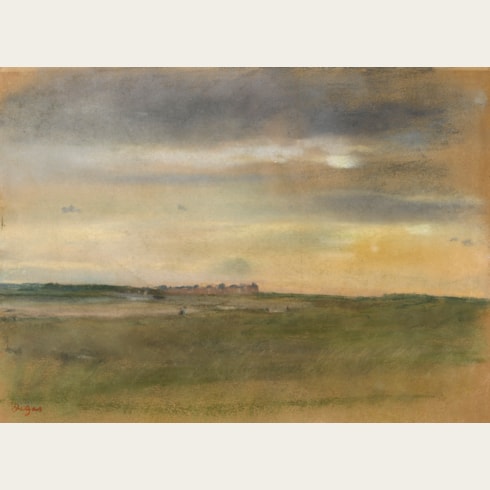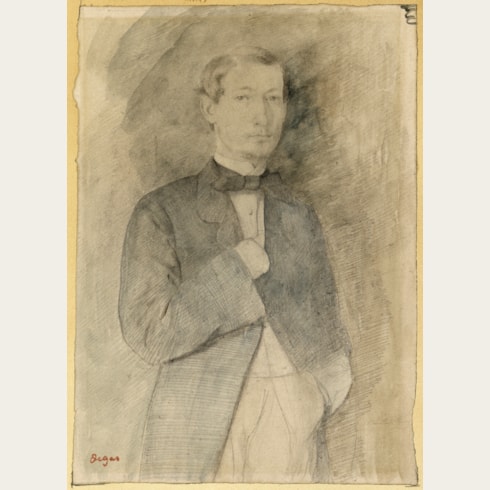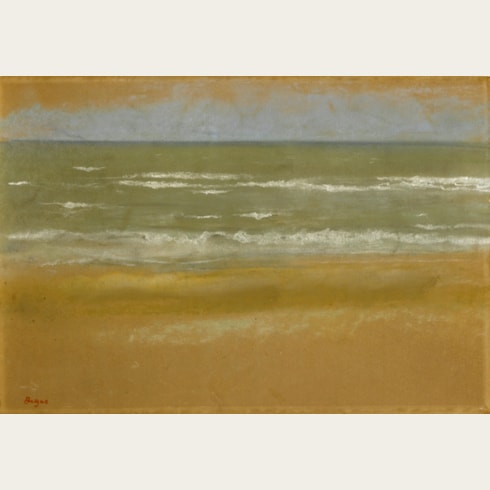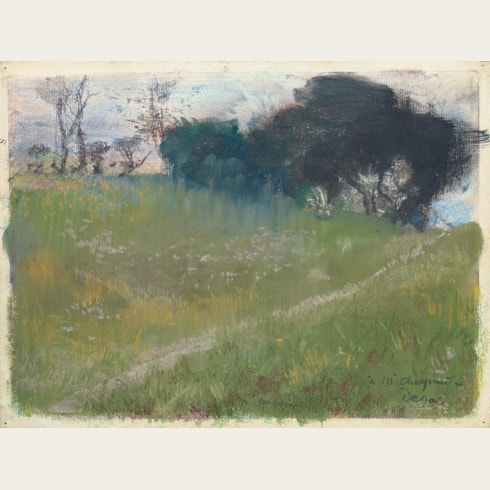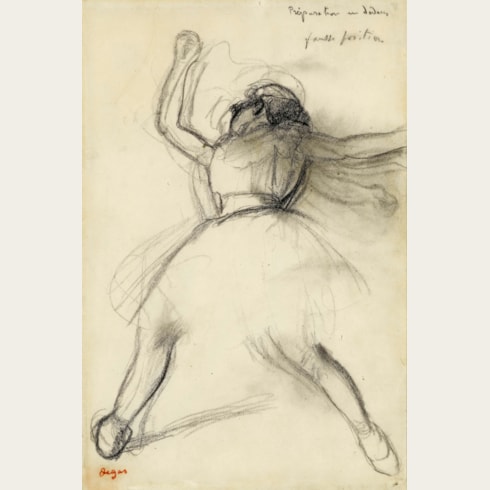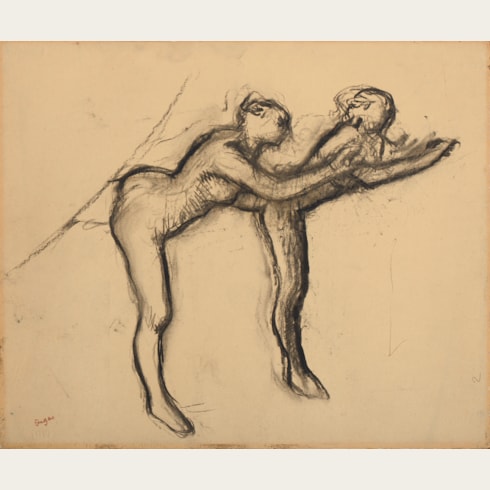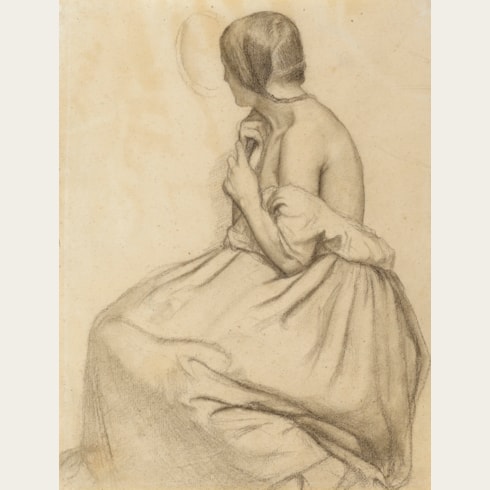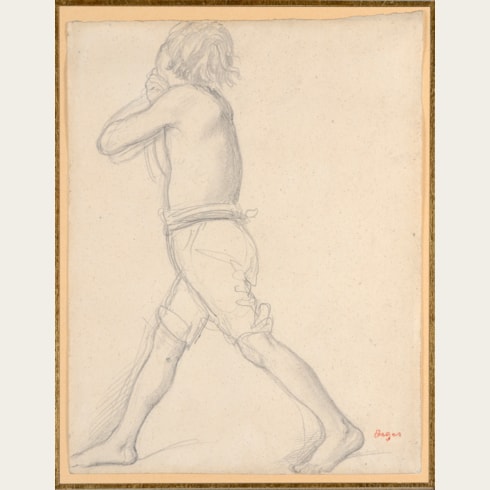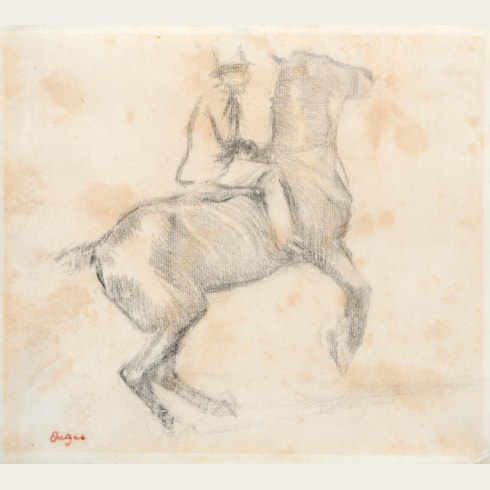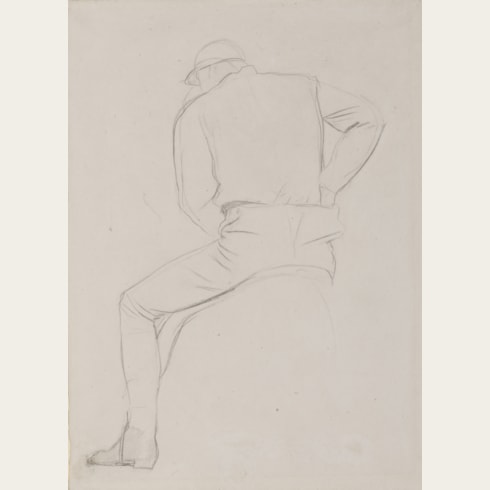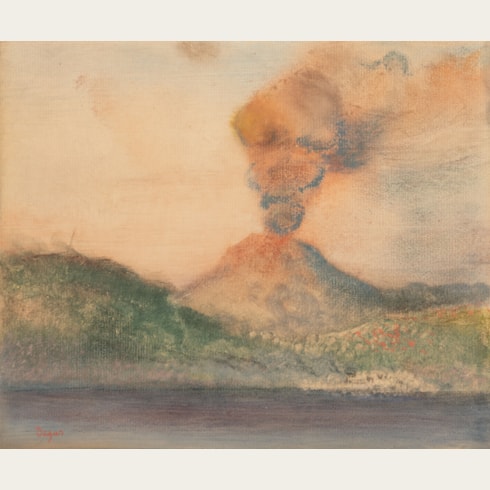Edgar DEGAS
(Paris 1834 - Paris 1917)
The Head of the Virgin, after Perugino
Sold
Pencil on coarse, flocked pale grey paper.
Stamped with the Degas vente stamp (Lugt 658) at the lower left.
280 x 207 mm. (11 x 8 1/8 in.)
Edgar Degas spent much of the early years of his career engaged in a serious study of Renaissance art, resulting in a significant number of drawn and painted copies by the artist. He first registered as a copyist at the Louvre in April 1853, and soon began making drawings after Old Master paintings in the museum’s collection, with a particular emphasis on Italian art of the 15th and early 16th centuries. Degas maintained the practice during his three-year stay in Italy between 1856 and 1859, drawing numerous copies after works in Florence, Rome and Naples; a task in which he was also encouraged by his father. In a letter of January 1859, written to his son in Florence, Auguste De Gas advised the young artist that ‘the masters of the fifteenth century are the only true guides; once they have thoroughly made their mark and inspired a painter unceasingly to perfect his study of nature, results are assured.’ On his return to Paris, Degas carried on copying works of art in the Louvre, and in fact continued to register as a copyist in the museum until 1862. Among the Quattrocento and Cinquecento paintings copied by the young Degas were works by Fra Angelico, Paolo Uccello, Filippino Lippi, Mantegna, Lorenzo di Credi, Vittore Carpaccio, Botticelli, Luca Signorelli, Leonardo, Michelangelo, Mantegna, Giovanni Bellini, Perugino, Raphael, Giorgione, Titian and many others. As the artist himself said, ‘One must copy and recopy the masters, and only after having given every proof of being a good copyist can one reasonably be expected to paint a radish from nature.’
Most of the drawn and painted copies by Degas may be dated to the formative years of the artist’s career, between 1858 and 1861, and several of the motifs and figures he copied were later integrated into his own paintings. As Theodore Reff has noted, ‘The interest in older art…was indeed so extensive in Degas’s early career, and at the same time so pervasive an influence on his own art, that his activity throughout the 1850’s may be described as essentially that of a copyist’, while another scholar has written that ‘Through copying Degas acquired at a very early stage that sureness and maturity which always astonished critics.’ In many of these early drawings Degas used a soft pencil and a coarse, flocked greyish paper, as in the present sheet.
This recently rediscovered drawing is a copy after the head of the Virgin in a panel painting of The Virgin and Child with Saints John the Baptist and Catherine of Alexandria by the Umbrian artist Pietro Perugino (c.1450-1523) in the Louvre. Painted around 1493, at the height of the Perugino’s career, this small devotional picture was acquired by the Musée du Louvre in 1821.
The present sheet is typical of Degas’ copies after Renaissance masters, and his own particular interest in individual studies of heads and figures, isolated from a more crowded composition. As one scholar has noted of Degas, ‘In loose drawings, and more rarely in oils, he recorded memorable portraits as he encountered them…Sometimes he singled out individual heads in altarpieces or frescos and treated them as portraits…His liking for the precision, for the unadorned purity of early portraits persisted for decades.’
Degas copied several other paintings by Perugino, including figures from an Ascension of Christ in the Musée des Beaux-Arts in Lyon, in a sketchbook now in the collection of the in the Bibliothèque Nationale in Paris. It was perhaps thinking of such paintings as those by Perugino that Degas is said to have once remarked: ‘So there is no bias in art? What about the Italian Primitives, who express the softness of lips by imitating them with hard lines, and make eyes come to life by cutting off the eyelids as if with a pair of scissors?’
Provenance
The studio of the artist, Paris
The fourth Vente Degas, Paris, Galerie Georges Petit, 2-4 July 1918, lot 113c (bt. Vignier)
Charles Vignier, Paris
His sale, Paris, Hôtel Drouot, 21 May 1931, lot 93
Bernard Chappard, Paris and Venezuela
His sale, Paris, Hôtel Drouot, 13 March 2000, lot 22
Private collection
Anonymous sale, London, Christie’s, 8 February 2007, lot 514.
Literature
John Walker, ‘Degas et les maîtres anciens’, Gazette des Beaux-Arts, September 1933, p.185; Franco Russoli and Fiorella Minervino, L’opera completa di Degas, Milan, 1970, pp.86-87, no.3; Marie-Anne Dupuy-Vachey, ‘Da David a Picasso, il Perugino e la Francia’, in Laura Teza, ed., Pietro Vannucci il Perugino: Atti del Convegno Internazionale di studio, 25-28 ottobre 2000, Perugia, 2004, p.378, p.394, fig.15; Caterina Zappia, ‘La sfortuna di Perugino nella Francia dell’Ottocento’, in Vittoria Garibaldi and Francesco Federico Mancini, ed., Perugino, il divin pittore, exhibition catalogue, Perugia, 2004, p.415, note 54; Annette Haudiquet et al., De Delacroix à Marquet: Donation Senn-Foulds – Dessins, 2011, pp.115 and 118 (‘Lots convoités par Olivier Senn dont les enchères ont dépassé les limites qu’il s’était fixées’); Oliver Kase, ‘>>Wo aller Lärm der Leidenschaft entfernt ist<<: Zur Popularität Peruginos im 19. Jahrhundert’, in Andreas Schumacher, ed., Perugino: Raffaels Meister, exhibition catalogue, Munich, 2011, pp.164-165; Andreas Schumacher, ed., Perugino: Raffaels Meister, exhibition catalogue, Munich, 2011, pp.278-279, no.38 (entry by Oliver Kase); Alexander Eiling, ed., Degas: Klassik und Experiment, exhibition catalogue, Karlsruhe, 2014-2015, pp.97-99, no.16 (entry by Alexander Eiling).






